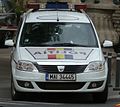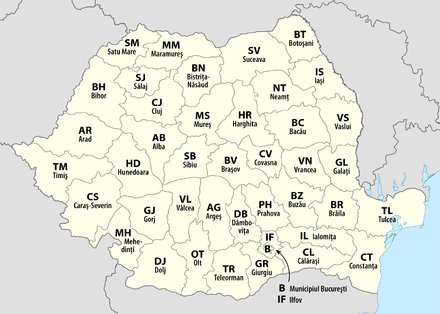License plate (Romania)
The current Romanian license plates were introduced in 1992 and show a blue stripe on the left with the twelve European stars and the nationality symbol RO . This is followed by a ( B for Bucharest) or two letters (for the respective circle) and an official badge. To the right of this, in addition to two (in Bucharest from 2010 three) digits, three letters appear. Before Romania joined the European Union in 2007, the Romanian national flag was shown in the blue bar. Two-line license plates usually show the bar in the bottom line.
You have the option of choosing the last three letters yourself for a fee. Under no circumstances may the letter block begin with I or O, as there is a risk of confusing the numbers 1 and 0. Until 1999, with the exception of the circle abbreviation, no I or O was allowed at all. The letter Q is generally not embossed. Letter combinations with sexual connotations such as COY , CUR , PUL , PIZ , MUI and MUE or that are reserved by authorities such as POL , DEP , SNT , SRI and MAI are not output.
License plate types
Identification of the municipalities
The municipalities issue special license plates with a yellow background for vehicles that do not leave their district . They usually show the municipality's coat of arms and two to six black characters. However, the design is the responsibility of the issuing municipality and can deviate from the one just mentioned. These labels are given to scooters, trams, trolleybuses, garbage trucks and combine harvesters, for example.

Leasing vehicles
There are separate license plates for leasing vehicles. These are the same as the normal license plates, but show a six-digit number after the district abbreviation and a red border on the right (similar to German export license plates ) with the expiry date of the leasing contract. After the contract expires, the license plate also loses its validity. You see this number very often with a "B" for Bucharest , as there are many leasing companies there.
Temporary license plates
Temporary license plates are in red. They show the circle abbreviation followed by three to six digits. The maximum validity of these signs is 30 days. They are only valid within Romania. The insurance expires automatically after 30 days. There is no approval, only a stamp with the registration number is applied to the original papers.
Diplomatic marks
Badges for the diplomatic service show blue letters and the letters CD , CO or TC . This is followed by two groups of three digits each, of which the first three encode the country of origin or the corresponding organization, the last usually the rank of owner. The smallest number in each group is 101.
Special identifier
Special indicators are z. B. awarded by ministries. Special license plates are currently being issued for vehicles belonging to the Ministry of the Interior and the Romanian Armed Forces . The army uses license plates that do not show a euro bar and begin with an A for Romanian Armata (German Army). Three to seven digits follow.
The license plates of the Ministry of the Interior show the letters MAI for Romanian M inisterul A dministrației și I nternelor and are u. a. used by vehicles of the Romanian gendarmerie (Jandarmeria) and police (Poliția).
Abbreviation
A total of 42 abbreviations currently exist for the Romanian circles (Romanian Județ , plural Județe ) and the city of Bucharest.
| Abbreviation | circle | main place |
|---|---|---|
| FROM | Alba | Alba Iulia |
| AG | Argeș | Pitesti |
| AR | Arad | Arad |
| B. | Bucharest city | |
| BC | Bacau | Bacau |
| bra | Bihor | Oradea |
| BN | Bistrița-Năsăud | Bistrița |
| BR | Brăila | Brăila |
| BT | Botoșani | Botoșani |
| BV | Brașov | Brașov |
| BZ | Buzau | Buzau |
| CJ | Cluj | Cluj-Napoca |
| CL | Călărași | Călărași |
| CS | Caraș-Severin | Reșița |
| CT | Constanța | Constanța |
| CV | Covasna | Sfântu Gheorghe |
| DB | Dâmbovița | Târgovişte |
| DJ | Dolj | Craiova |
| GJ | Gorj | Târgu Jiu |
| GL | Galați | Galați |
| GR | Giurgiu | Giurgiu |
| HD | Hunedoara | Deva |
| MR | Harghita | Miercurea Ciuc |
| IF | Ilfov | Buftea |
| IL | Ialomița | Slobozia |
| IS | Iași | Iași |
| MH | Mehedinți | Drobeta Turnu Severin |
| MM | Maramureș | Baia Mare |
| MS | Mureș | Târgu Mureș |
| NT | Neamț | Piatra Neamț |
| OT | Olt | Slatina |
| PH | Prahova | Ploieşti |
| SB | Sibiu | Sibiu |
| SJ | Sălaj | Zalau |
| SM | Satu Mare | Satu Mare |
| SV | Suceava | Suceava |
| TL | Tulcea | Tulcea |
| TM | Timiș | Timișoara |
| TR | Teleorman | Alexandria |
| VL | Vâlcea | Râmnicu Vâlcea |
| VN | Vrancea | Focșani |
| VS | Vaslui | Vaslui |
System 1968 to 1992
The system introduced in 1968 already had a white base color and black writing. The signs began with a maximum two-digit number encoding the type of vehicle, followed by the circle abbreviation. Today's abbreviations were largely used in the old system. This was followed by a maximum five-digit number.
The diplomatic license plates introduced in 1958 represented a special feature: They were oval and had the red letters CD in the upper line , and a three-digit number underneath.
| number | Vehicle type |
|---|---|
| 1 - 19 | Cars, from 1990 private vehicles of all kinds |
| 20th | Car, reserve, never used |
| 21-30 | light commercial vehicles |
| 31 - 40 | heavy commercial vehicles and buses |
| 41-45 | Tractors |
| 46-50 | Two-wheelers |





